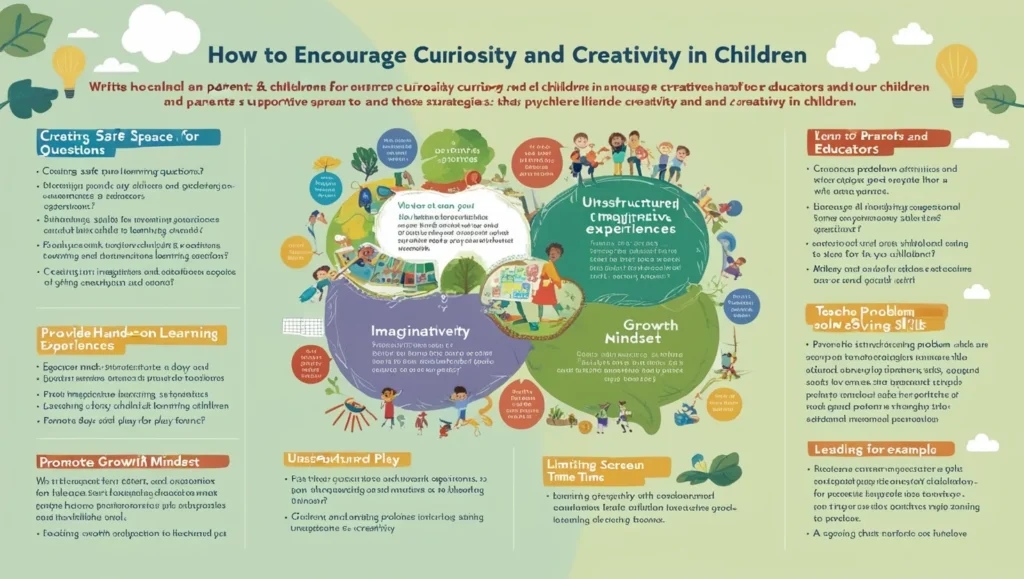Encourage Curiosity and Creativity in Children
In a rapidly changing world, nurturing curiosity and creativity in children has become more important than ever. These traits fuel innovation, critical thinking, and problem-solving skills, which are crucial for success in both personal and professional spheres. By fostering an environment that values exploration and imaginative thinking, parents and educators can empower children to grow into confident and resourceful individuals. Here’s an in-depth look at strategies to encourage curiosity and creativity in children. Encourage Curiosity and Creativity in Children
1. Create a Safe Space for Questions and Exploration
Children are naturally curious, and their incessant “why” questions are a sign of active exploration. To nurture this curiosity:
- Be Open to Questions: Encourage children to ask questions and never dismiss their inquiries, no matter how trivial they may seem. A supportive environment helps them feel valued and understood.
- Model Curiosity: Share your own questions and demonstrate how you seek answers. For instance, if you wonder about the stars, involve your child in researching astronomy.
- Avoid Judging Ideas: Let them explore even unconventional thoughts without fear of being ridiculed or corrected too quickly.
2. Provide Opportunities for Hands-On Learning
Experiential learning is one of the best ways to spark curiosity and creativity.
- Science Experiments: Simple, fun experiments like making a volcano with baking soda and vinegar can ignite scientific curiosity.
- Artistic Endeavors: Provide materials like crayons, clay, or paints for open-ended creative projects. Encourage them to create without focusing on the end result.
- DIY Projects: Build something together, like a birdhouse or a simple robot, to merge creativity with practical skills.
3. Encourage Imaginative Play
Imaginative play helps children think outside the box and develop problem-solving skills.
- Role-Playing: Let children play pretend as doctors, astronauts, or chefs. This stimulates their imagination and allows them to explore different roles and ideas.
- Storytelling: Ask your child to invent a story or collaborate with them to write one. This develops both their creativity and language skills.
- Use Everyday Items: Allow them to transform household items into props, like turning a cardboard box into a rocket or castle.
4. Introduce Diverse Experiences
Exposure to a variety of activities broadens a child’s perspective and fuels curiosity.
- Travel and Explore: Visiting new places, whether it’s a museum or a forest, provides endless opportunities for discovery.
- Introduce New Hobbies: From gardening to photography, exposing children to a range of activities can help them discover new passions.
- Read Widely: Books transport children to different worlds, cultures, and ideas. Encourage them to read stories, nonfiction, and poetry.
5. Cultivate a Growth Mindset
A growth mindset teaches children to embrace challenges and see mistakes as opportunities to learn. Encourage Curiosity and Creativity in Children
- Celebrate Effort, Not Just Success: Praise the process of learning and trying, even if the outcome isn’t perfect.
- Teach Resilience: Explain that failure is a part of learning and encourage them to keep experimenting.
- Ask Open-Ended Questions: Instead of asking yes/no questions, ask ones that require thought, like “What do you think would happen if…?”
6. Limit Screen Time and Encourage Unstructured Play
While technology can be a powerful learning tool, too much screen time can stifle creativity. Encourage Curiosity and Creativity in Children
- Set Screen-Time Boundaries: Designate specific times for screen use and prioritize educational or creative apps.
- Unstructured Playtime: Encourage time for free play, where children can decide how to spend their time without structured guidance.
7. Be a Supportive Mentor
Your role as a parent or teacher is to guide, support, and inspire children’s creative journeys.
- Listen Actively: Pay attention to their ideas and questions. Show genuine interest in what excites them.
- Provide Resources: Offer access to books, tools, and materials that align with their interests. For example, if they love space, get them a telescope.
- Join Their Exploration: Engage in activities with them. If they’re curious about gardening, plant seeds together and watch them grow.
8. Teach Problem-Solving Skills
Problem-solving is a key aspect of creativity. Help children learn to approach challenges with an open mind. Encourage Curiosity and Creativity in Children
- Pose Challenges: Give them puzzles or problems to solve, such as building the tallest tower with blocks or figuring out how to navigate a maze.
- Encourage Experimentation: Let them test different solutions, even if they fail at first. Celebrate their willingness to try again.
- Collaborate: Work with them on challenges to demonstrate teamwork and creative thinking.
9. Foster a Love for Nature
Nature is a boundless source of inspiration and curiosity.
- Explore the Outdoors: Take children on hikes, to the beach, or simply to the backyard to observe plants, animals, and weather patterns.
- Gardening: Allow them to plant seeds and watch them grow, teaching them patience and care.
- Observe and Document: Encourage them to keep a nature journal to record what they see, draw pictures, or write about their experiences.
10. Lead by Example
Children often mimic the adults in their lives. Be the role model they need to embrace curiosity and creativity.
- Be Curious Yourself: Show enthusiasm for learning new things, whether it’s cooking a new recipe or picking up a new skill.
- Stay Creative: Share your creative hobbies, such as painting, writing, or playing an instrument, and invite them to join.
- Celebrate Discovery Together: Treat learning as a shared adventure, celebrating each new discovery as a team.
Final Thoughts
Encouraging curiosity and creativity in children isn’t just about teaching them new skills—it’s about fostering a mindset of exploration, wonder, and resilience. By creating an environment where questions are welcomed, imagination is celebrated, and challenges are embraced, you can help children develop the tools they need to navigate an ever-changing world. Ultimately, these traits will empower them to think critically, innovate, and adapt, ensuring they grow into confident, capable individuals ready to tackle whatever comes their way. Encourage Curiosity and Creativity in Children

